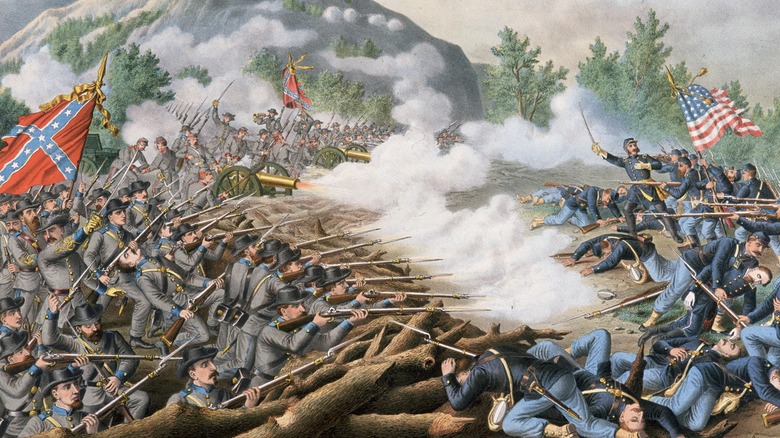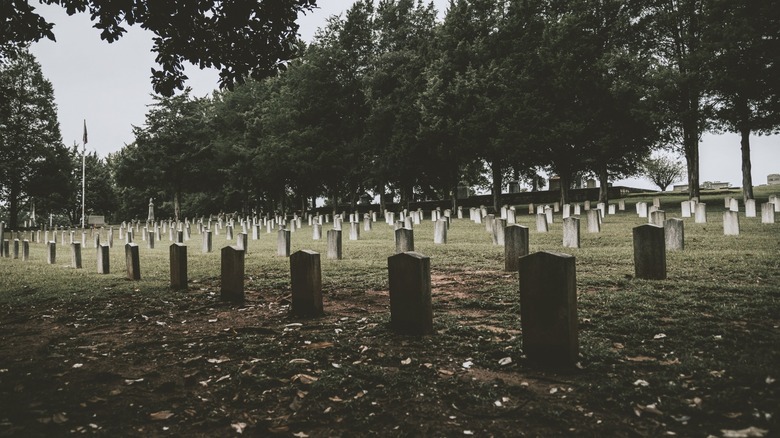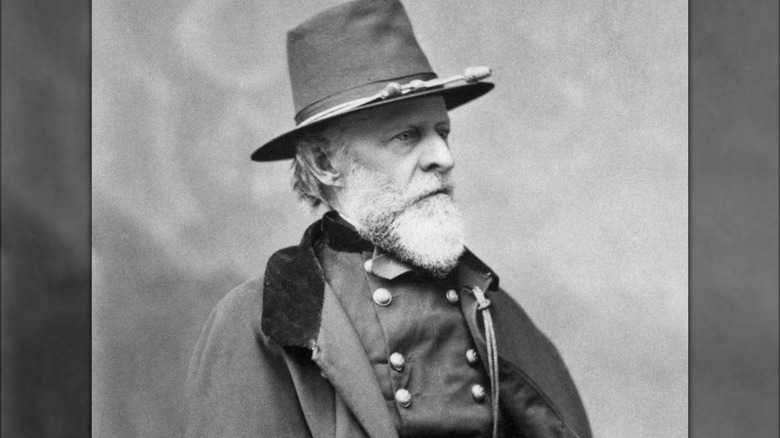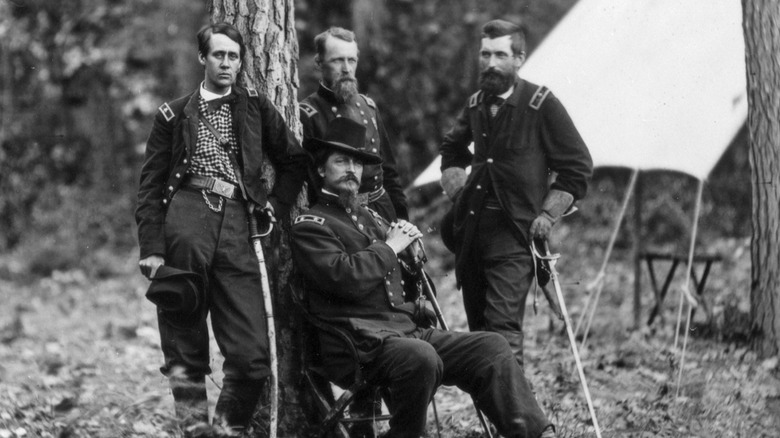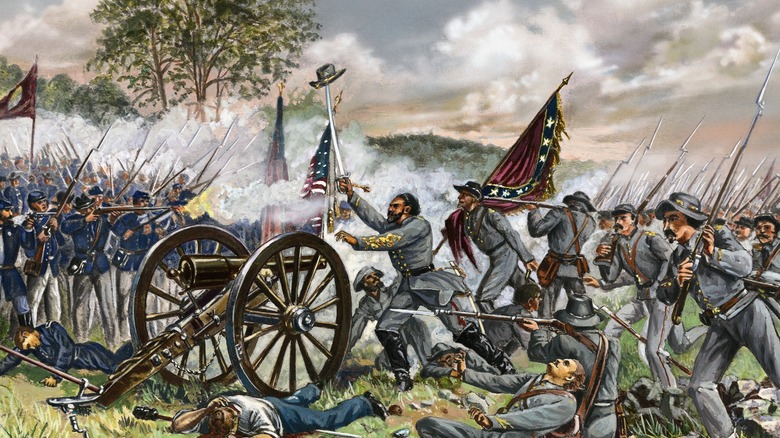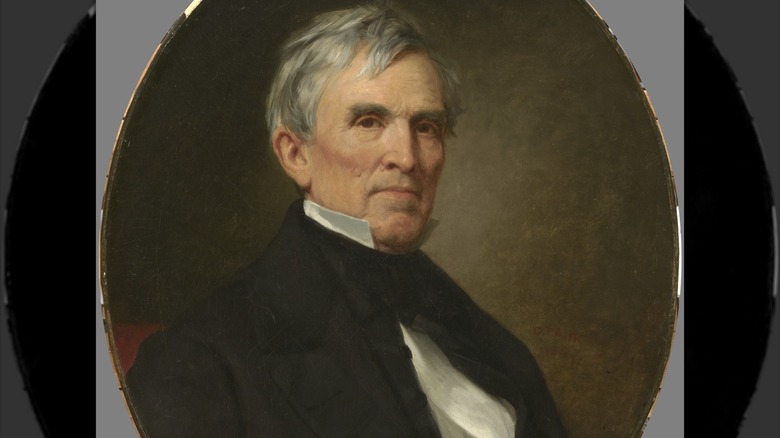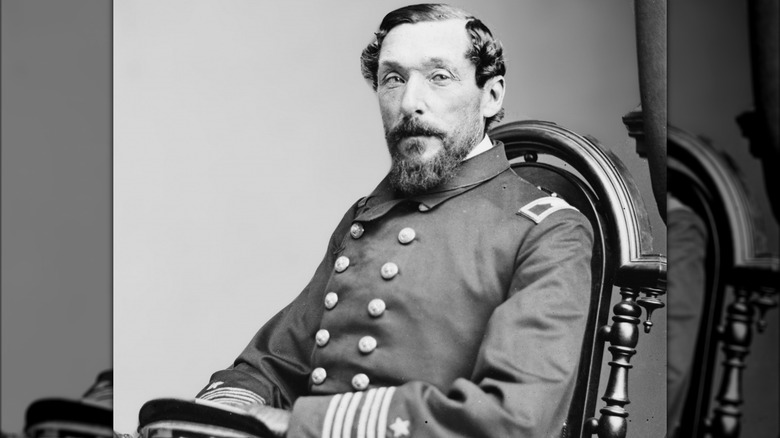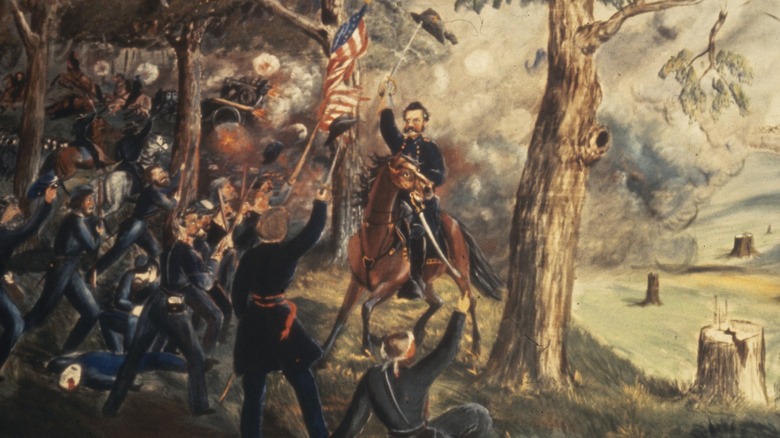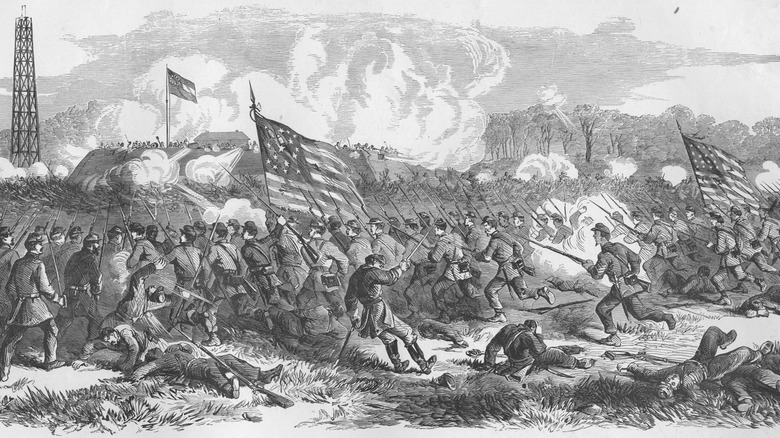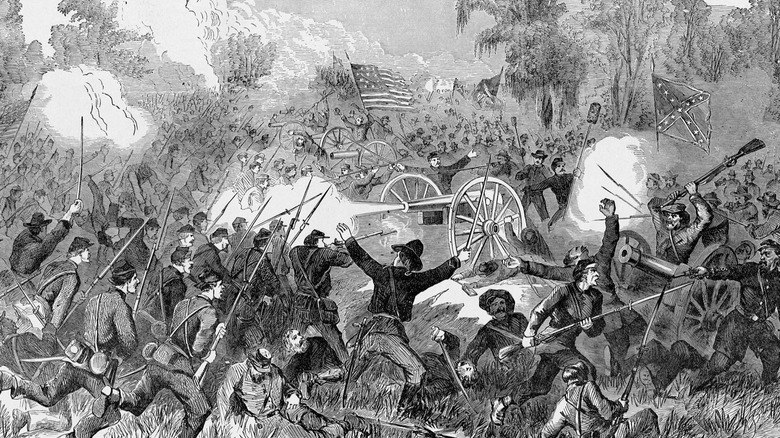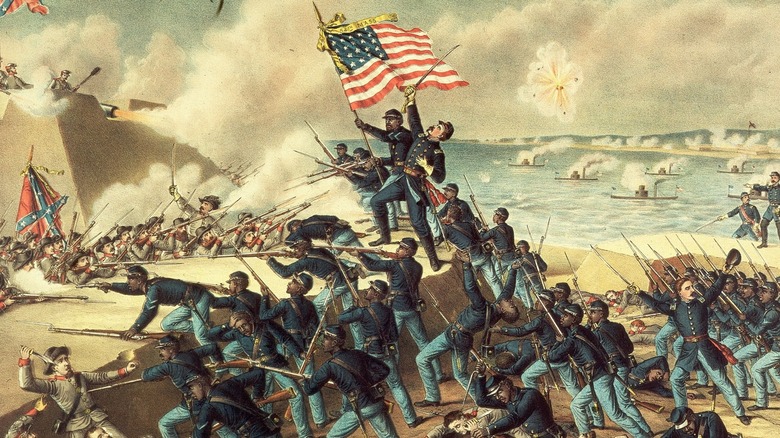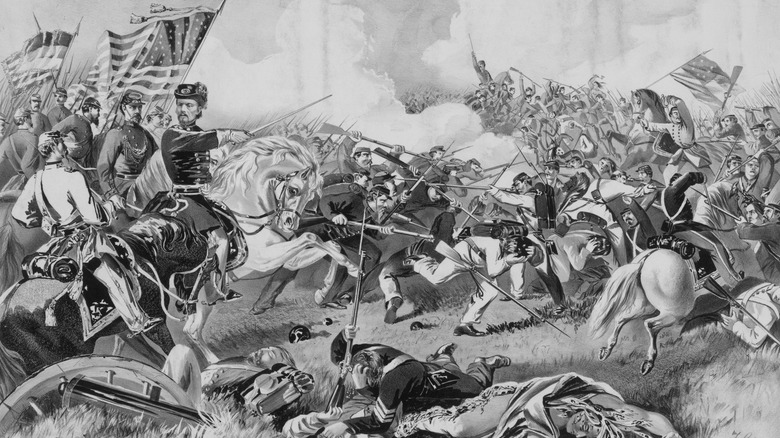Families Who Fought On Both Sides Of The American Civil War
Part of what made the American Civil War such a tragic and horrific event was the fact that it literally split families apart almost overnight. Brothers and sisters who one afternoon shared a household, the next week were in completely different countries. Yet, they probably felt as if they were in completely different worlds. The choice was not easy for many: whether to continue supporting the only country they had ever known, or to join with their kinfolk in open rebellion and insurrection. But everyone had to make a decision.
In many cases, family members found themselves not just on opposite sides of the political and ideological spectrum, but also literally on opposite ends of the battlefield. While it may have been rare for siblings, parents, and children to actually fire their weapons at each other, there were many families who had members serving simultaneously in both the Union and Confederate armies.
It's hard to imagine the incredible despair and anguish that would come from fighting a close relative, but countless families endured such incredible heartache to support what they felt was right. The Civil War was arguably the most tumultuous time in American history, and it shattered countless families.
The Terrill family (from Virginia)
Years before the Civil War, it was already clear that the Terrill family had divergent tendencies with respect to the North and South. While William Rufus Terrill attended West Point Academy in New York, his brother James Barbour Terrill instead attended the Virginia Military Institute (VMI) located in Lexington. Their father, William Henry Terrill, had served on the Board of Visitors for the VMI, and needless to say he was very much in support of secession. A third Terrill brother, Philip Mallory, left his studies at the University of Virginia to join the state's Confederate infantry when the war started.
This put William Henry, James, Philip, and even their brother-in-law (by way of marriage to their sister Emily) George Porterfield, on the side of the Confederacy from the very beginning. However, even though he was offered a commission in the Confederate Army, William Rufus declared his loyalty to the Union, a decision that was met with extreme consternation and anger back home. When he found out his son was contemplating staying in the Union, William Henry wrote to William Rufus that he would be a traitor and would be removed from the family history. Philip was also upset, and wrote to his sister to express his dismay.
Tragically, William Rufus, James, and Philip Terrill were killed in the war. Never having a chance to reconcile or reunite, all three went to their graves as members of a shattered family.
The Cooke family
For many of those who were from the South but served in the Union Army when the Civil War broke out, there was an incredibly tough decision to be made: Stay loyal, or secede? While many decided to embrace secession and back their native states, others remained loyal to the Union they had been serving for years (or in many cases even decades). One of the men who had to make that decision was Union Bvt. Maj. Gen. Philip St. George Cooke (pictured).
When Cooke decided to remain loyal to the Union, not only was he disavowing his home state of Virginia, but he was also creating a massive rift within his family. Cooke's son, John Rogers Cooke, chose to leave the Union Army and join the Confederacy when the war broke out. Even worse from a family perspective, Philip's daughter Flora Cooke also chose the Confederacy, as she was married to infamous Confederate Gen. J.E.B. Stuart.
Stuart reportedly gave the now-famous line "He will regret it but once and that will be continually" in regards to his father-in-law's decision to stay a Union man (via Virginia Encyclopedia). While Stuart died fighting in 1864, both father and son Cooke survived the war, later reconciling in the 1880s, just a few years before Philip's death.
The Gibbon family
Few families were as entangled in the American Civil War as the Gibbons were. The Gibbon family featured no less than seven members fighting in the Civil War, and only one of them was on the Union side. That was Gen. John Gibbon (above right), who defied literally his entire family to stay loyal to the Union. Gibbon's family had originally been from the North, but they relocated to North Carolina in the late 1830s. Fully embracing life in the South, the family eventually came to own slaves in North Carolina before the Civil War broke out.
John Gibbon graduated from West Point in the 1840s and joined the Union Army afterward. When war broke out, he remained loyal to the Union, which was in stark contrast to the rest of his family. His slaveholding father was obviously in favor of secession, and all three of his brothers, two of his brothers-in-law, and even his cousin, all fought against him as part of the Confederate Army.
Gibbon appears to have actually faced one of his relatives, a cousin named James Johnston Pettigrew, at the Battle of Gettysburg. Pettigrew was taking part in the infamous "Pickett's Charge," the disastrous Confederate attack that resulted in massive casualties, while Gibbon was on the other side defending against the assault. Pettigrew would ultimately die at Gettysburg, while Gibbon was seriously wounded. Quite the family reunion.
The Goldsborough brothers
While there were many families that fought on opposite sides during the Civil War, it was pretty rare to actually meet a relative on the battlefield. The story of the Goldsborough brothers almost defies logic.
When the war broke out, William Goldsborough became a Confederate while his brother Charles Goldsborough remained a Unionist. The Goldsboroughs hailed from Maryland, and William joined the Maryland Confederate Infantry in 1861, eventually becoming a major in the unit. In contrast, Charles became a surgeon for the Union Army, joining in 1861 after the death of his wife the year prior. The two brothers would meet on the battlefield on May 23, 1862, at Front Royal. Charles was working as a surgeon for the Maryland Federal Infantry as they were fighting against William's Confederate Marylanders. The Confederates decisively defeated the Maryland Federals at Front Royal, and it was there that William took his brother Charles into custody as a prisoner of war.
It's hard to imagine what Charles was thinking at the time, but he was probably pretty sore not only to lose the battle, but also to suffer the indignity of being captured by his older brother. Luckily, their relationship does not appear to have been permanently damaged. After the war, the two reconciled, and they spent much of their final years together in their adopted hometown of Hunterstown, Pennsylvania, reunited as brothers.
The Crittenden family
Of all the families split up by the Civil War, the Crittenden family is perhaps the most famous — or infamous, depending on which side you are talking about. The patriarch of the family was John Crittenden (pictured), a former state legislator and U.S. senator. Crittenden played a big part in the political discussions leading up to the outbreak of the war, as he was the author of the failed "Crittenden Compromise." The proposal aimed to avert the war by confining slavery to the South and keeping it illegal in the North, but it never passed.
One of the reasons Crittenden likely wanted to avert the country going to war is because he knew both of his sons would be involved, though he was probably hoping they would at least fight for the same Union side that he supported. One of his sons, Thomas Leonidas Crittenden, did stay with the Union, but his other son, George Bibb Crittenden, seceded with the Confederacy. Their cousin, Thomas Turpin Crittenden, stayed loyal and fought for the Union.
Both of the Crittenden brothers became commissioned officers during the war, with George becoming a major general and Thomas a brevetted brigadier general. All three of the younger Crittendens survived the war, while John died of natural causes in 1863.
The Drayton brothers
Brothers Thomas and Percival Drayton's relationship was shattered by the Civil War. In the antebellum years, the Drayton brothers spent their childhoods growing up together in South Carolina, but Percival (pictured) moved north with his father when he was around 20 years old in 1832, leaving his slightly older brother behind.
By the time the war broke out in 1861, the brothers had already been arguing over which side was right, and as a letter from Thomas to Percival shows, things were becoming pretty heated (via the Historical Society of Pennsylvania). Thomas wrote to Percival just after the Battle of Fort Sumter in April 1861, which was the first battle of the war and ended in a Confederate victory. In his letter, Thomas makes it clear that the issue of slavery is dividing the brothers, though he takes exception to the idea that supporting the Confederacy meant "battling for slavery against freedom." He rages against his brother for not seeing the North as the aggressors in the war, calling them "traitors" but stopping short of calling his brother selfish and corrupt. While we don't have Percival's response, it's clear that the Civil War was severely fracturing their relationship.
Ultimately, Thomas would make brigadier general for the Confederates, while Percival became a captain for the Union. Unfortunately, they never had a chance to mend their relationship, as Percival died in 1865, just months after the war ended.
The McBeath brothers
Perhaps the McBeath family more than anyone else truly personified what it was like to be ripped apart by the Civil War, only to have to put things back together after the bullets stopped flying. In the years before the war, brothers Anthony and William McBeath lived at home with their mother and sister in Wayne County, Kentucky (via Wayne County Genealogy Trails). When the war began, the family was split apart. William appears to have joined the Union Army with the 5th Iowa Cavalry (via the Denver Public Library), while Anthony seems to have joined a Kentucky unit for the Confederacy (via Western Kentucky University).
Eventually, William received a commission and achieved the rank of major in the Union Army, and both of the brothers returned home following the conclusion of the fighting. Yet, while William was proudly wearing his officer's uniform, Anthony's uniform was falling apart — just like his unit on the battlefield. The juxtaposition of the two brothers really shows the true effects of the Civil War on American families, especially those that were torn apart.
Just the sight of Anthony looking so ragged was enough to upset their sister Susan, who wept when she saw him. For the McBeath family, there were no winners and losers, as they all felt the pain of Anthony's defeat. But luckily both McBeaths survived the war — a luxury countless families did not have.
The Campbell brothers
Born in the 1830s in Scotland, the Campbell brothers somehow managed to find themselves fighting against each other during the American Civil War. Arriving in the United States in the 1850s, James Campbell decided to live in Charleston, South Carolina, while his younger brother Alexander "Sandy" Campbell and their sister headed North to New York City instead.
James later joined the Confederate Army while Sandy fought for the Union. Incredibly, they actually met each other at the Battle of Secessionville in James' home state of South Carolina in 1862. As the battle was happening, neither realized the other was there, and when they found out afterward they were clearly conflicted. James wrote a letter to Sandy saying he never wanted to fight him again during the war, but conceded they may have to if duty called. At one point, James even approached the Union line in an attempt to visit his brother, but was turned away by the officer in charge.
In a letter to his wife, Sandy touched on one of the most salient parts of fighting your brother during a war: hoping to win while also hoping your brother — the enemy — survives uninjured. James and Sandy each had to fire at the opposing side, knowing his brother might be on the receiving end of the bullet. With no guarantee the other would not be in the line of fire, it must have been a gut-wrenching experience. Luckily, both the Campbells survived the war and remained close.
The McLaughlin family
The McLaughlins were another family that found themselves torn apart by the American Civil War, as brothers John and Henry McLaughlin were on opposing sides of the conflict. The family was originally from Indianapolis, but the brothers started to grow apart after Henry moved away to Florence, Alabama.
While fighting the war, the McLaughlin brothers were reunited, but in the worst way possible. During the Battle of Champion Hill on May 16, 1863, John's Federals were taking on Henry's Confederates, and the Federals came out victorious. However, after the battle Henry was confined in a Union prison after being captured by his older brother John. After his capture, Henry tried to plead with his Unionist sister that he was loyal to the United States like his brother, and she finally got President Abraham Lincoln to pardon Henry in 1865, after he'd spent more than a year and a half as a prisoner of war. It's unknown if the brothers ever reconciled, and John taking Henry into custody may very well have been their last interaction, which would be a true tragedy.
The Terrill family (from Kentucky)
For the Terrill family from Boone County, Kentucky, the Civil War was a tumultuous time, to say the least. During the war, the family found themselves completely fractured, with two brothers fighting for the Union and three for the Confederates (via the Boone County Public Library). In addition, many of their cousins and extended family also found themselves fighting in the war, and many of them were split, too. The Kentucky Terrills were related to the Virginia Terrill family that included brothers James, William Rufus, and Philip, all of whom died during the fighting and who were also divided between the Confederacy and Union.
For the Kentucky Terrills, it was William and Robert who fought for the Union, while George, Joshua, and Simeon all fought for the Confederates. In addition, a regiment of Black soldiers included two Terrills from Boone County, suggesting they might have been enslaved by members of the Terrill family before making their way to Union lines and joining the army to fight against their former enslavers (via the Boone County Public Library).
Only Simeon died during the war, with the four others surviving through the end. Incredibly, fighting for different sides did not seem to destroy their relationship, and they returned home after the war and lived without conflict. It shows how powerful the idea of family was for the Kentucky Terrills, who had a chance to heal that the Virginia Terrills never got.
The McIntosh brothers
While most brothers engage in competition and one-upmanship, James and John McIntosh took things to a whole new level during the Civil War. When the war broke out, James, the elder of the two, decided to secede with his native Florida and join the Confederacy. When James, who had previously been a member of the U.S. Army, left to join the Confederacy, his brother John joined the Union Army, perhaps to take his place.
Apparently, it was James leaving the Union for the Confederacy that spurred John's decision to enlist, as he was working as a businessman in New Jersey when the war began. As a member of the Union Army, John achieved the rank of brevetted major general at the end of the war, while James would get as high as brigadier general.
Unfortunately, the McIntosh brothers were never able to reconcile. James died during the Battle of Pea Ridge in 1862, and the McIntoshes became another family tragically torn apart by the Civil War.
